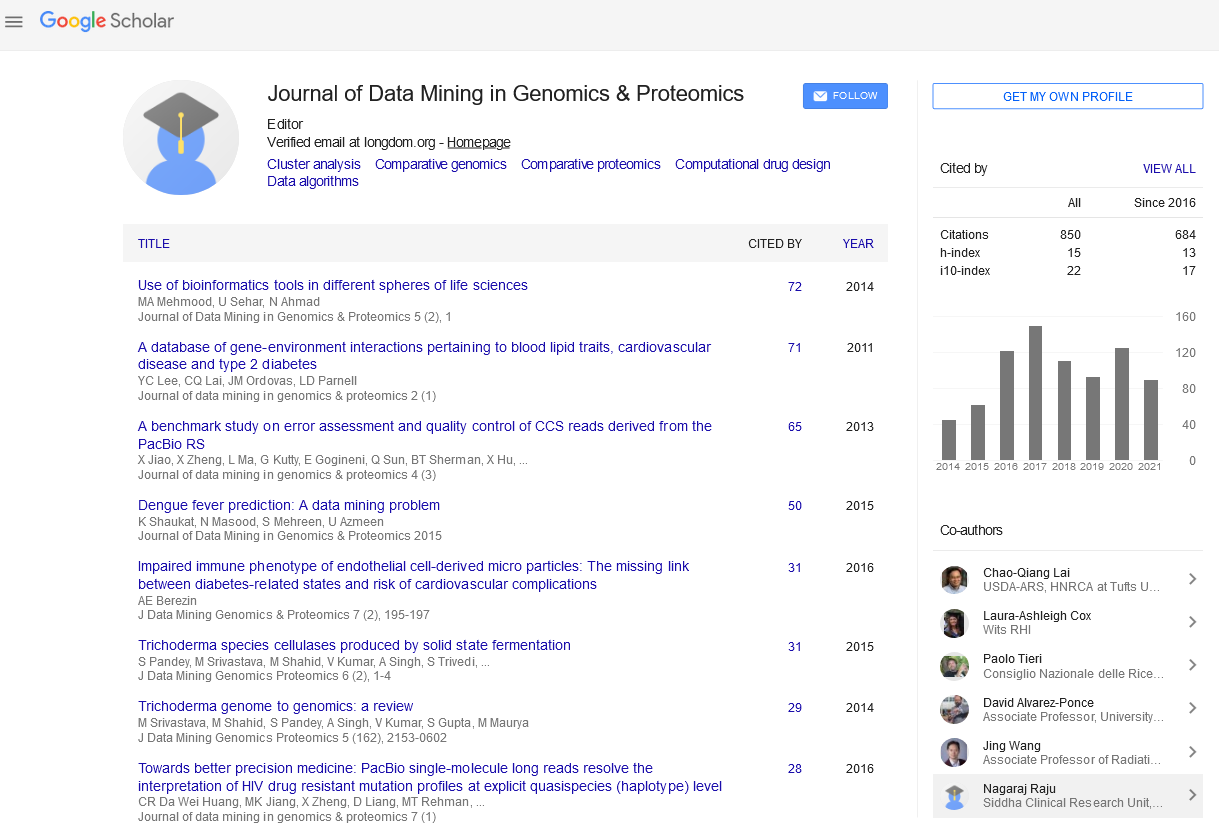PMC/PubMed Indexed Articles
Indexed In
- Academic Journals Database
- Open J Gate
- Genamics JournalSeek
- JournalTOCs
- ResearchBible
- Ulrich's Periodicals Directory
- Electronic Journals Library
- RefSeek
- Hamdard University
- EBSCO A-Z
- OCLC- WorldCat
- Scholarsteer
- SWB online catalog
- Virtual Library of Biology (vifabio)
- Publons
- MIAR
- Geneva Foundation for Medical Education and Research
- Euro Pub
- Google Scholar
Useful Links
Share This Page
Journal Flyer

Open Access Journals
- Agri and Aquaculture
- Biochemistry
- Bioinformatics & Systems Biology
- Business & Management
- Chemistry
- Clinical Sciences
- Engineering
- Food & Nutrition
- General Science
- Genetics & Molecular Biology
- Immunology & Microbiology
- Medical Sciences
- Neuroscience & Psychology
- Nursing & Health Care
- Pharmaceutical Sciences
Radiation-induced transcriptional modulation of microRNA
2nd International Conference on Big Data Analysis and Data Mining
November 30-December 01, 2015 San Antonio, USA
M. Ahmad Chaudhry
University of Vermont, USA
Posters-Accepted Abstracts: J Data Mining Genomics Proteomics
Abstract:
The cellular response to ionizing radiation (IR) exposure is complex and involves many pathways. To gain insight into this complex response, global gene expression alterations have been examined. The molecular basis of gene regulation in cells exposed to IR is not fully understood. Gene regulation occurs at the transcriptional and post-transcriptional levels. MicroRNAs (miRNAs) play a significant role at the post-transcriptional gene regulation by negatively regulating the stability or translation of target messenger RNA. miRNA are associated with many cellular processes. Because miRNA target so many genes, we hypothesized that alterations in their expression may be associated with the overall response of cells to radiation treatment. Several studies reported from our laboratory showed miRNAs disturbances after radiation treatment. Dose, dose rate and time dependent changes in the relative expression of many miRNA were seen. The miRNA expression levels were altered in cells exposed to as low as 10 cGy dose. miRNAs were differentially regulated in irradiated cells differing in DNA repair capability or p53 status. We also showed miRNA transcriptional changes in radiation-induced bystander cells. The expression patterns of many miRNA markedly differed within the same cell line after exposure to either low or high doses of radiation. We observed downregulation of genes that were targeted by radiation-upregulated miRNA. In contrast, the target genes of downregulated miRNAs were upregulated. The genome-wide expression changes of miRNA transcriptome by massively parallel sequencing corroborated previously observed miRNA expression changes. To further understand miRNA role in IR-induced stress pathways, we generated a list of predicted target genes and identified cellular pathways where miRNA predicted target genes function. In addition to confirming previously identified IR stress pathways, we were able to identify novel pathways that have not been identified in cellular radiation response. Our analysis indicates that the miRNA interactome provides a platform for comprehensive modeling of the cellular stress response to IR exposure.
Biography :
M. Ahmad Chaudhry received a Ph.D. degree in molecular biology from the University of Manchester, UK. Currently he is an Associate Professor in the Department of Medical Laboratory and Radiation Sciences, University of Vermont. He has published 42 peer reviewed scientific papers and has reviewed over one hundred manuscripts that were submitted for publication to 32 international scientific journals. He is a reviewer for 5 national and international funding agencies and has served on NIH study sections. He is currently serving on editorial board of four international scientific journals.


